The Sapphire R9 280X Toxic Review
by Ryan Smith on October 10, 2013 8:00 AM EST- Posted in
- GPUs
- Radeon
- Sapphire
- Tahiti
- Radeon 200
Power, Temperature, & Noise
Having seen the gaming performance of the 280X Toxic, let’s move on to power, temperature, and noise to get a better look at the performance characteristics of Sapphire’s Tri-X cooler. This will also give us a chance to evaluate the costs of Sapphire’s significant factory overclock with respect to power consumption.
| Radeon 280X Series Voltages | ||||||
| Sapphire 280X Boost Voltage | Sapphire 280X Base Voltage | Asus 280X Boost Voltage | XFX 280X Boost Voltage | Ref 7970GE Boost Voltage | ||
| 1.263v | 1.2v | 1.2v | 1.2v | 1.218 | ||
At the base GPU clockspeed of 1110MHz Sapphire is able to stick to 1.2v for their GPU voltage, but to boost up to 1150MHz they have to go to 1.256v. This is high for a Tahiti chip, and although still in the safe zone for something with this large an air cooler it is reaching about as high as we like to take Tahiti while maintaining longevity.
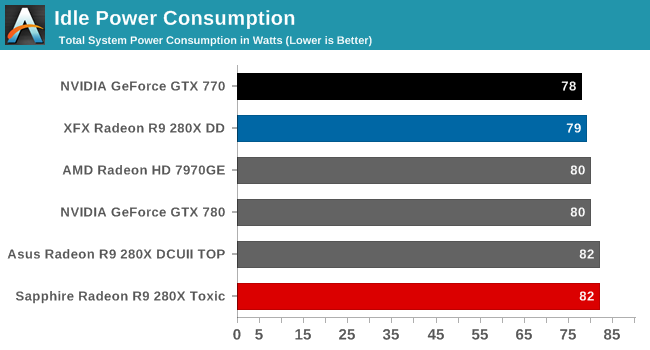
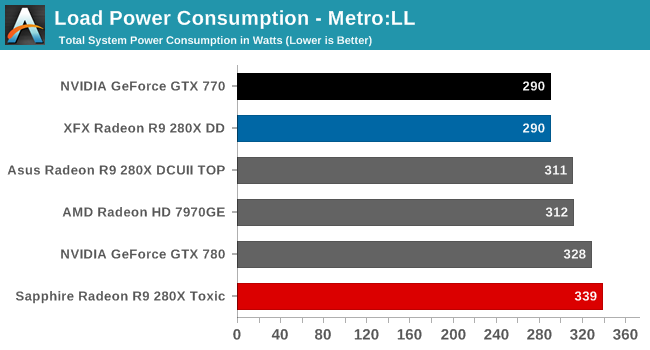
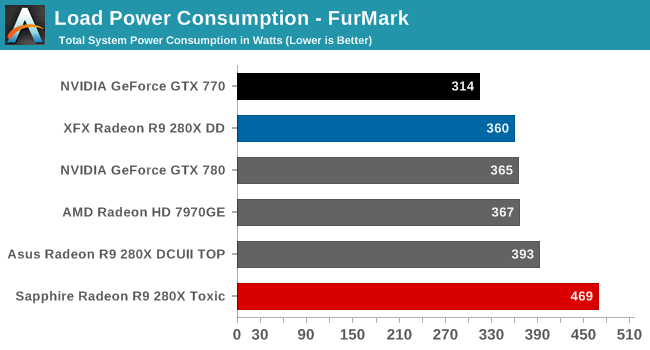
With the increased clockspeeds and voltages, rather expectedly we see an increase in power consumption. 339W (at the wall) under Metro is nearly 50W more than the stock 280X, and still 28W more than the overclocked (but not overvolted) Asus card. In fact it’s more than even the GTX 780, a card that still beats the 280X Toxic in our benchmarks.
FurMark shows a similar trend, with the 280X Toxic sustaining a load over 100W more than the stock 280X, or the GTX 780 for that matter. Sapphire has clearly set the PowerTune limit on their card higher in compensation for the amount of power a higher clocked, higher voltage GPU will take, and they have the cooling to back it up, letting the card draw this much power and sustain it. FurMark is a pathological case and gaming power consumption will be much closer to the Metro scenario, but it does show how high the Sapphire card can go under extreme load.
Consequently it’s clear that Sapphire has regressed some on the power curve to hit their performance targets. 1150MHz is unquestionably outside Tahiti’s sweet spot, so there is a significant power penalty to pay to get there.
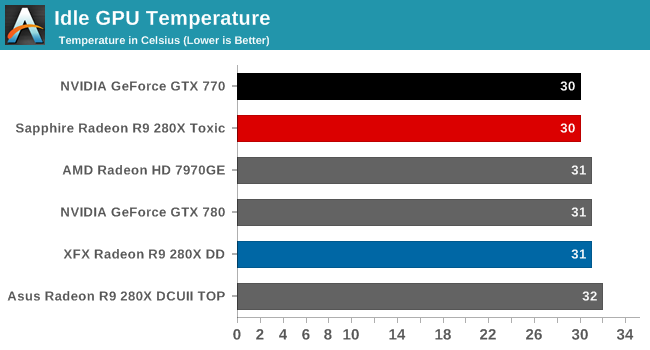
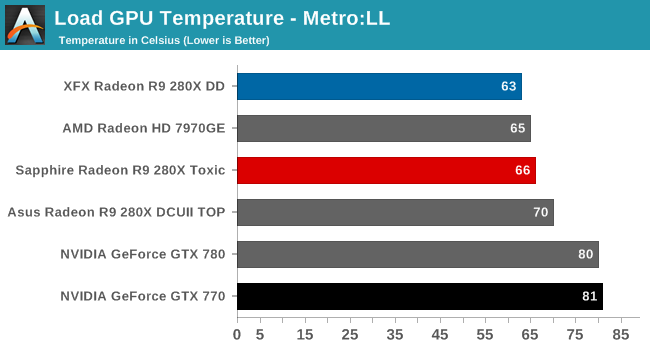

Considering the power numbers we just saw, Sapphire’s Tri-X cooler is earning its keep and then some. 66C under Metro is doing quite well for an open air cooled card drawing this much power, and the fact that FurMark temperatures only go to 75C despite the extreme power load there only further proves that the Tri-X cooler is up to the task for the Toxic. In spite of the high power draw, the card will have no trouble keeping up.
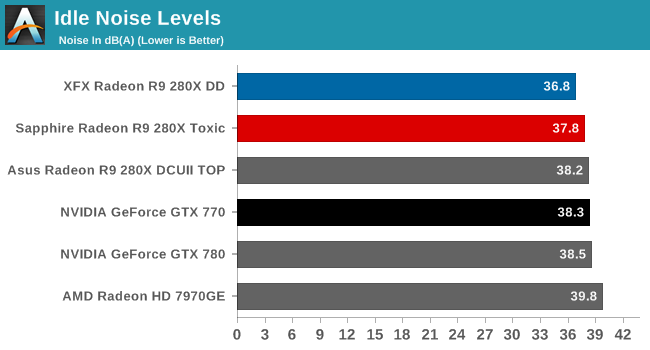
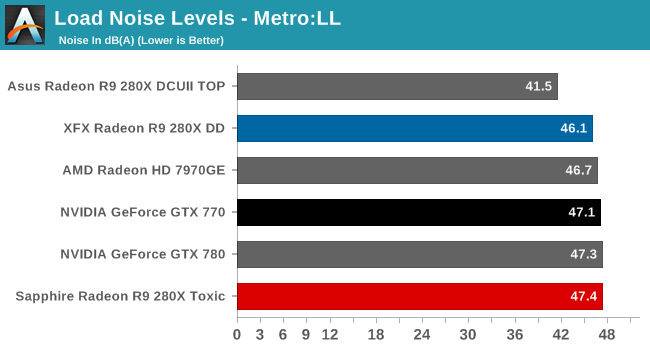
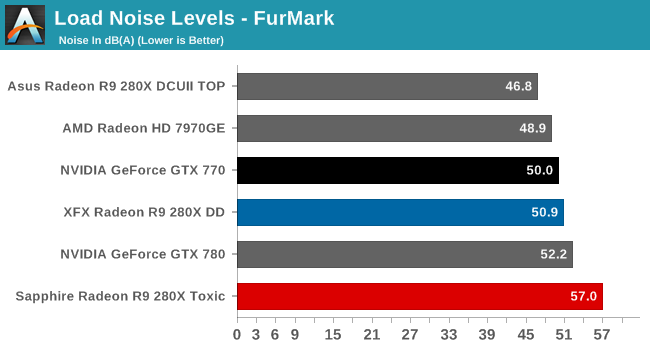
Finally our look at noise is something of a mixed bag for the 280X Toxic. The noise levels under Metro aren’t bad, but they’re also not great. At first glance Sapphire’s fan curve may be a bit aggressive, which is why we have 66C temperatures next to a 47dB(A) noise level. Next to the stock-clocked XFX card that’s a negligible increase in noise for a 13% performance increase, but the Asus card is something of a spoiler here. Asus in comparison gave up some cooling performance in exchange for lower noise levels and it shows. Sapphire could likely stand to be a bit less aggressive on cooling and bring those noise levels down, at least going by the conditions and results in our testbed.
FurMark on the other hand is outright loud, again going back to just how much power this card can draw when given a pathological use case and allowed to run free. I’m not sure if Sapphire could get away with a less aggressive fan curve here given the 75C temperature that goes with this noise level. Our testing methodologies don’t capture noise levels for other games, but based on our testing experience I don’t expect the card to get anywhere close to this under any game load, as those have always reflected what we see with Metro. Distributed computing/Bitcoin users likely wouldn’t be happy with this card though.
Ultimately Sapphire’s Tri-X cooler performs well under load here for typical workloads, and at least can easily keep up with the Toxic’s high power consumption under extreme workloads. The mixed results here ultimately come down to power consumption rather than the cooler itself.










84 Comments
View All Comments
ShieTar - Monday, October 14, 2013 - link
Test results depend strongly on the case used for the testing and also on the geometry of the measurement room, most importantly the distance between the card and the microphone.I seem to remember that AT is testing with the card in an open setup, while kitguru are referring to a closed chasis in the review you have linked.
Ryan Smith - Monday, October 14, 2013 - link
For general testing we're in a closed setup, specifically a NZXT Phantom 630 (as listed in our test apparatus section).Also, keep in mind that our intention here is for these results to be relative, not absolute. We're primarily concerned with which card is louder/quieter and by how much. The problem with absolute results is that more so than any other attribute we test, it varies heavily with the environment, both with regards to the case and the room the computer is setup in.
FuriousPop - Thursday, October 10, 2013 - link
hhmmmmm.........not that impressive from the red team and im guessing the 290X will just be a supe'd up 280X (hopefully not). but i think i'll be sticking with my cfx 7970's (asus top versions)... but if the green team drop the 770/780's in price then i do believe those will be a price - performance wise bargin... i guess we must still wait for the 290X to come.....and see...Mombasa69 - Monday, October 14, 2013 - link
"hhmmmmm.........not that impressive from the red team" LMAO! It's near 30% faster than a standard 7970 and is full DX11.2... numb nuts. Even beats a 780 on half the benchmarks and the true Radeon optimized games designed for the new Radeon using consoles aren't even out yet.All this for only £260-£280!
jenesis33 - Thursday, October 10, 2013 - link
NV already stated they are not dropping price for GTX 770 / 780.So yeah. i understand this is not impressive for ppl arleady have 7970 and etc.
But for some1 like me who is upgrading from a GTX 560, i think it's great news.. Awesome performance for price...
FuriousPop - Thursday, October 10, 2013 - link
i disagree - for those in your position i would rather upgrade to a gtx670 or 7850 (or there abouts), save those extra bucks for early next year or better yet, stick with what you got now and purchase something early-mid next year. i only got my 7970's late last year, before that i had a 4870 for as long as i can remember (tried 2xgtx670's but 1 of them DOA, hence 7970 the only choice).prices will always drop - my thoughts have always been whats the best value not what is the best performer out there.... and with this 280X power hunger mode on, i don't see the 290X being any better in that department therefore requiring more out of your whole system to utilize the full performance of it, to which i don't think its worth it....but hey, go nuts if you like!
Yeoman1000 - Friday, October 11, 2013 - link
You can always wait, but you can never really win with tech. In the uk, 7850 is about £110-130. 7970 can be had for £210-230. Bear in mind the 3gb & 384-bit...for peeps in the uk at least it seems like 'old' 7970 stock is the same excellent value as a 7850, for now at least it seems you can't lose.commissar0617 - Saturday, October 12, 2013 - link
WHO CARES ABOUT POWER CONSUMPTION? a 200w power draw difference will mak minimal difference if your power bill....ShieTar - Monday, October 14, 2013 - link
For a serious gamer (1000 hours a year at least), with assumed electricity cost of 0.20$ / kWh, thats already 40$ a year. Keep in mind that people who need to watch that kind of money are often students, some of them playing (and/or working) more than 1000 hours a year, and also keep in mind that some of the international readers of AT may also pay 0.50$/kWh, and you may also be looking at 200$ or more cost per year. Most people won't call that minimal.That aside, I personally do not worry about 60$ electricity per year, but 200W additional draw will lead to a noticeable increase in noise, and that I do care about a lot. So I most definitely care to see those numbers in any review.
Mombasa69 - Monday, October 14, 2013 - link
I'll be upgrading my 3 way 570's for 2 of these Sapphire Radeon R9 280X Toxic's, it even comes with a great oc utility, a small tweak and it'll be as good as the over-priced 780.